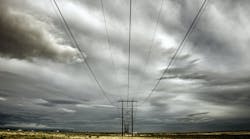California ISO Approves Key Stage of Southwest Intertie-North Project
In a major step augmenting western electric grid interconnectivity and resource diversity, the California ISO Board of Governors has approved an addendum to its 2022-2023 Transmission Plan to conditionally advance development of a 285-mile link in a transmission pathway that would deliver Idaho wind to California and the Southwest and enable Idaho Power to import additional energy into its system.
During its final meeting of the year Thursday, the Board also elected Jan Schori as its new chair and named Severin Borenstein vice-chair, effective Dec. 31. In the annual rotating of the gavel, Schori will take over from Mary Leslie, becoming the third consecutive woman in that role.
In conditionally approving the 500-kV Southwest Intertie Project-North (SWIP-North), the board took action to enable the project to move into the next stage of development. That will include the California and Idaho Public Utilities commissions completing their assessment of interest in the project and the project sponsor, LS Power, submitting its application to become a Participating Transmission Owner with the California ISO, including commercial terms and conditions.
Final decisions on the project by the ISO Board and the Federal Energy RegulatoryCommission (FERC) would be targeted for the end of 2024 and early 2025, respectively.
The project will connect to a longer 600-mile transmission line already delivering power between east central Nevada to just south of Las Vegas, where the Harry Allen substation connects into the ISO system.
“As planned, the Southwest Intertie Project will open up more than 1,100 megawatts of new capacity to the California ISO network and support the state’s goal of accessing clean wind resources from Idaho,” said Elliot Mainzer, California ISO president & CEO. “The line will provide valuable additional connectivity between California, Nevada and Idaho, with the potential to benefit electricity consumers by accessing cost-effective renewable energy and improving grid reliability.”
In a memorandum to the Board, the ISO transmission planning staff said the new link will “provide resource diversity, improve reliability by creating a parallel path to the California Oregon Intertie (COI) line, reduce congestion costs on the COI, reduce renewable resource curtailment, and enable the ability to export excess solar from the state.”
The line is proposed to run from Robinson Summit substation in central Nevada to Midpoint, ID. In tandem with an existing capacity sharing agreement between LS Power and NV Energy, the line would allow the ISO to tap into abundant wind resources reaching the Harry Allen substation in southern Nevada, while providing more than 500 MW of capacity for the ISO to flow north to Idaho.
The line is currently estimated to cost about $1 billion and the ISO will ultimately be responsible for 77.2% of the overall project costs, with Idaho Power evaluating a 22.8% share in the project associated with its portion of south to north capacity. The ISO’s approval is conditioned on Idaho Power’s involvement. Project costs will be reviewed regularly and will ultimately need approval from the FERC. The line is projected to be operational in 2027.
Stakeholders weighing in on the project were in general support of the ISO proposal, including labor groups, based on the conditional next steps. Advancing the new transmission project is one of the top accomplishments during the year that Leslie was ISO Board Chair. Other notable accomplishments during her tenure include approval of a $7.3 billion transmission plan; adoption of an innovative “subscriber” participating transmission owner model to support the TransWest Express line bringing wind energy from Wyoming to California; and the Board’s historic approval of the Extended Day-Ahead Market (EDAM).
“This was a monumental year for electricity transmission, and I’m proud to have been a part of the advancement of policies, market designs and projects to accommodate the substantial amount of new, clean, reliable resources needed to keep California’s economy humming through the next generation,” she said.
Schori will continue the work of the ISO’s reliability and renewable energy initiatives as the new Board Chair beginning in January. She will leverage her extensive background in the electric utility industry, including 14 years as general manager and CEO of the Sacramento Municipal Utilities District and later, as an independent trustee of the North American Electric Reliability Corp. She follows Leslie and Angelina Galiteva in the role of Board chair.


